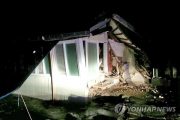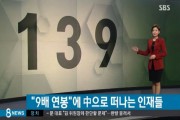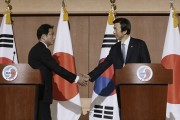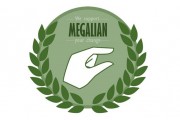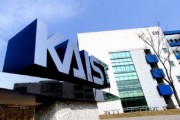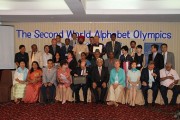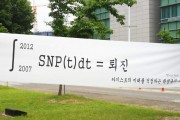From Chosum Ilbo:
Korea’s first humanoid robot, Hubo, wins international disaster relief robot competition

Team KAIST’s DRC-HUBO posed for a photo in preparation for the DARPA Robitics Challenge in Pomona, California. DRC-HUBO is the most powerful version among the previous Hubo series.
Korea’s first humanoid robot ‘HUBO’ was crowned as the world’s best disaster relief robot.
On June 5th, Hubo won first place in the DARPA Robotics Challenge (DRC) at Fairplex in Pomona, California, after outperforming traditionally strong American, Japanese and German robotics teams. It was held by the Defense Advanced Research Projects Agency (DARPA) that belongs to the US Department of Defense. The Korean team received 2 million dollars as a prize. “Running Man” of Florida Institute for Human and Machine Cognition (IHMC) won the second place and “Tartan Rescue” of Carnegie Mellon won the third.
DRC started in 2013 with a goal to develop robots that can replace humans in extreme environments such as the damaged nuclear plants in Fukushima in 2011. Arati Prabhakar, the head of DARPA, said, “A new challenge to overcome disasters for humanity has begun through the competition. All participants will make their software available to the public, so that anyone can freely use and improve it.”
24 teams participated in the final round of the DRC. For Korean teams, Ttolmang of Robotis, Ttolmang SNU of Seoul National University and Hubo of KAIST took part in the competition. On the 6th, Hubo successfully completed the eight tasks such as driving, opening a door, closing a valve and climbing stairs within 45 minutes, overwhelming other competing robots. Only Hubo, Running Man and Tartan Rescue were able to finish all eight tasks.
Hubo, created by Professor Oh Jun-ho in the mechanical engineering department at KAIST in December 2004, is Korea’s first bipedal robot. Most parts and software used in the robot were made by the KAIST team except for some sensors. Professor Oh developed “DRC Hubo 2”, a robot suitable for disaster environments for the competition. He said, “I’m proud that I was able to show our robot’s excellence by outperforming world-renowned American and Japanese research teams.”
For more details of the competition, please refer to the following articles.
How South Korea’s DRC-HUBO Robot Won the DARPA Robotics Challenge
DARPA Robotics Challenge: Amazing Moments, Lessons Learned, and What’s Next
Comments from Naver:
sgit****
Congrats, Hubo~ When you return to Korea, don’t forget to wear a mask~
heoe****
It’s great ^^
hisa****
You did a great job. Congratulations!
croa****
Wow, it’s great. I want to see Hubo.
crib****
And there is not a single picture in this article. [Photos were added later.]
kin8****
It’s great. They deserve applause since they won against German, Japanese and American teams. KAIST independently developed Hubo while the government did nothing for them. It was the second humanoid robot in the world. Germany that makes the best cars. Japan that makes the best robots and electronics. The US that makes the best software. KAIST beat teams from those countries. They made it 50 years after farmers were using ox carts in Korea.
blue**** [Responding to above]
How is Hubo is the world’s second humanoid robot?;; In Japan alone, there have been several. Even in Korea, it’s not the second one, is it?
kypa**** [Responding to kin8****]
The government did nothing? KAIST is a national university to begin with. The students receive national scholarships. The Hubo team receives 200 million won every year for 10 years. Geez.
3456**** [Responding to kin8****]
DRC is regarded as the world’s biggest robotics competition where even NASA, Lockheed Martin and MIT teams participate. Congratulations, Professor Oh for winning with pride.
penw**** [Responding to kin8****]
FYI, most prominent robotics companies or research centers (Boston Dynamics) in developed countries did not participate in this competition where they have to reveal all their technologies. There is no incentive for them to focus on the disaster relief area and the prize amount is meaningful only for small research teams. No major groups pay attention to it. The competition did not show the best of the robotics industry. DARPA simply wanted to promote interest in disaster relief robot research. Humanoid robots are not yet in the stage for commercial usage. If they can stably demonstrate basic tasks, it is considered the cutting-edge. Honda’s Asimo is famous. Those ones who have no reason to take part in the competition are the cutting-edge. The competition is just to motivate those who need to catch up. There is still a long way to go for the Korean teams to reach the top level.
skyc**** [Responding to penw****]
It is not a minor competition. Funny how you judge by the prize amount, keke. Then can you name any major competition? DRC is the one that showcases the best humanoid robot technologies.
han3**** [Responding to penw****]
If you don’t know jackshit, just stop your bullshit. Boston Dynamics belongs to the American military and they have almost alien technologies. Team SCHAFT who won last year’s competition were the ones who worked on the Asimo project. Except for those taken over by Google and Boston Dynamics, all world-renowned teams participated in this year’s competition. Whether it is unmanned vehicles or robots, fine tuning is important for competitions. It depends on who spends more time and effort. We should give applause to Professor Oh’s vision lab that made a nice comeback after last year’s defeat. He was talking with Google’s vice president last year. Who knows what will happen?
mukt**** [Responding to above]
It is true that the companies taken over by Google did not participate in the competition. Since it is still not a very profitable industry yet, university research teams are the cutting-edge.
13th****
In America and Japan, they get astronomical amounts of funds for research. I’m so proud of KAIST winning without much support!
jhki****
Professor Oh, you’ve been digging a single well [focusing on one specialty]. You’ve finally made it. Congratulations. I hope you keep focusing on that one area instead of branching out.
wrea****
Wow, how come an article like this doesn’t have many comments? ㅠㅠ I’m so proud of the Korean robot. Good work, KAIST researchers!! [The article ended up getting more than 800 comments later.]
feri****
Not surprised it was KAIST.
